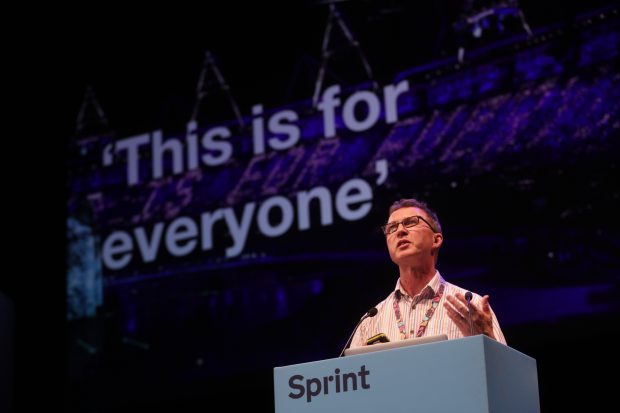
I am the interim Head of Accessibility and Senior Accessibility Specialist at the Government Digital Service (GDS). This means I run the cross-government Introduction to Accessibility training.
In these sessions, I ask people why digital accessibility is important. I often get the obvious answer that accessibility is a legal requirement, but also that it is the right thing to do; that making things accessible for a particular group often helps improve the experience for everyone.
Imagine you are on a train
Accessibility isn’t just about permanent or even temporary disabilities. Have you ever tried accessing a website on a train?
You might experience situational impairments. Your movement can be restricted. The train vibrates making it difficult to click on links or operate small buttons. Background noise and interruptions can affect hearing and concentration. Sunlight, particularly when the sun is low in spring and autumn, can make things difficult to read.
You can’t stop many of these things from happening, but good accessible design can help reduce the effects.

How do you explain a picture over the phone?
Think about the different senses. The information in a picture can’t be seen by someone who is blind. Images sometimes contain text, but even if they don’t, they often contain important information. Users of screen reader software need that information described in text, as it can be easily converted to speech. The text, known as alt or alternative text, should not just be a literal description of the picture, but should be the information the picture conveys.
Audio content on your pages may not be directly available to someone who is deaf or hard of hearing. Try turning the sound off on an instructional video which doesn’t have captions, and see how much you can understand. Providing captions (or ‘subtitles’, as we tend to call them in Europe) helps many people. A useful side-effect of this is that by providing captions, you can improve your search engine ranking.
How do you embed accessibility?
One area that has largely remained unaddressed is the accessibility of documents, particularly PDFs (Portable Document Formats). GDS recommends avoiding publishing via PDF whenever possible, because the PDF format was created for printed documents, and therefore lacks much of the built in structure and consistency of HTML and CSS web pages.
PDFs can be made accessible, but require quite a lot of work to do so. Start with accessible templates for all new documents, and use Acrobat Professional to test the accessibility of PDFs (although I acknowledge it is often not an available option because of cost).
How do you test accessibility?
The Web Content Accessibility Guidelines (WCAG) have been used as the base standard for the accessibility of central government services, and they are now part of the new accessibility regulations.
But they aren’t the easiest set of documents to read and understand. We have tried to help by creating a WCAG primer and providing guidance on how to approach the regulations for the public sector and GOV.UK service teams. I also highly recommend the Home Office accessible design posters as a way of explaining good design principles for accessibility.
The minimum requirement for accessibility for the new accessibility regulations is the Web Content Accessibility Guidelines v2.1 level A and level AA, but the word minimum is key here. The new regulations don’t replace or supersede the Equality Act 2010, the Disability Discrimination Act (Northern Ireland only) or the Public Sector Equality Duty.
Whilst meeting all those requirements will help make things accessible, it doesn’t guarantee that everyone will be able to access your website or service. For government services we go beyond that standard by requiring testing with commonly used assistive technologies, and testing with older and disabled users, and we also encourage conforming to some of the level AAA requirements.
Make sure the accessibility train doesn’t leave without you. It won’t wait.
To learn more about the requirements of the new regulations, visit GOV.UK/accessibility-regulations. You can follow Richard Morton on Twitter at @accessibleweb and GDS at @GDSTeam


8 comments
Comment by Wedge posted on
But surprised that the steam train photo is a 365KB screenshot PNG, and not the original JPG, optimised down to 100 or 200KB.
Comment by Clarence Hooper posted on
This is an interesting subject but such a dry read. A shame. What happened to the engaging GDS style?
Comment by Travis posted on
Hi. Nice article. Although I was surprised to see a GDS blog with questions as subheadings (because of poor scannability, inefficient use of language). I wondered if there was a reason for this? Thanks!
Comment by Richard Morton posted on
Hi Travis,
It wasn't a conscious decision. I wrote this in a semi-conversational style, similar to how I would run training sessions. It could, of course work without questions so "How do you explain a picture over the phone?" could have been "How to explain a picture over the phone". That would probably be a better way of writing it if this was meant to guidance rather than a blog post.
Comment by C delaney posted on
This is interesting, thanks, but the images in this blog don’t appear to have any alt text. Is there a reason for this?
Comment by The GDS Team posted on
Hi,
We've inspected the image elements and they have alt texts according to the code. Can you please let us know how you are attempting to view the alt text?
Thanks,
The GDS Team
Comment by Wedge posted on
It might be that some people conflate title with alt; title can show when one hovers the cursor over the image.
Comment by Neil Alton posted on
"Black steam train approaching a foot crossing" is the alt text